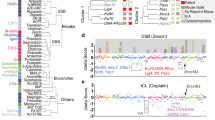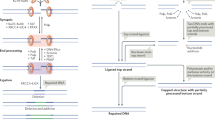Abstract
Double-strand breaks (DSBs) are intermediates in several physiological processes including V(D)J and class switch recombination. They are also potent substrates for chromosomal translocations that arise as by-products of antigen receptor gene assembly in lymphocytes. ATM is one among several key proteins involved in the detection, signaling and repair of DNA breaks. Despite redundancies in DSB signaling pathways, it has recently been demonstrated that ATM deficient lymphocytes can survive and proliferate several generations in vitro and in vivo despite harboring terminally deleted chromosomes produced by V(D)J recombination. In this review, we discuss how two complementary genome maintenance functions mediated by ATM prevent lymphocytes from adapting to persistent DNA damage.
This is a preview of subscription content, access via your institution
Access options
Subscribe to this journal
Receive 50 print issues and online access
$259.00 per year
only $5.18 per issue
Buy this article
- Purchase on Springer Link
- Instant access to full article PDF
Prices may be subject to local taxes which are calculated during checkout


Similar content being viewed by others
References
Awa AA, Sofuni T, Honda T, Itoh M, Neriishi S, Otake M . (1978). Relationship between the radiation dose and chromosome aberrations in atomic bomb survivors of Hiroshima and Nagasaki. J Radiat Res (Tokyo) 19: 126–140.
Bassing CH, Chua KF, Sekiguchi J, Suh H, Whitlow SR, Fleming JC et al. (2002). Increased ionizing radiation sensitivity and genomic instability in the absence of histone H2AX. Proc Natl Acad Sci USA 99: 8173–8178.
Bassing CH, Suh H, Ferguson DO, Chua KF, Manis J, Eckersdorff M et al. (2003). Histone H2AX: a dosage-dependent suppressor of oncogenic translocations and tumors. Cell 114: 359–370.
Bertoni F, Codegoni AM, Furlan D, Tibiletti MG, Capella C, Broggini M . (1999). CHK1 frameshift mutations in genetically unstable colorectal and endometrial cancers. Genes Chromosomes Cancer 26: 176–180.
Bredemeyer AL, Sharma GG, Huang CY, Helmink BA, Walker LM, Khor KC et al. (2006). ATM stabilizes DNA double-strand-break complexes during V(D)J recombination. Nature 442: 466–470.
Callen E, Jankovic M, Difilippantonio S, Daniel JA, Chen HT, Celeste A et al. (2007). ATM prevents the persistence and propagation of chromosome breaks in lymphocytes. Cell 130: 63–75.
Celeste A, Difilippantonio S, Difilippantonio MJ, Fernandez-Capetillo O, Pilch DR, Sedelnikova OA et al. (2003). H2AX haploinsufficiency modifies genomic stability and tumor susceptibility. Cell 114: 371–383.
Celeste A, Petersen S, Romanienko PJ, Fernandez-Capetillo O, Chen HT, Sedelnikova OA et al. (2002). Genomic instability in mice lacking histone H2AX. Science 296: 922–927.
Chen HT, Bhandoola A, Difilippantonio MJ, Zhu J, Brown MJ, Tai X et al. (2000). Response to RAG-mediated VDJ cleavage by NBS1 and gamma-H2AX. Science 290: 1962–1965.
Cuadrado M, Martinez-Pastor B, Murga M, Toledo LI, Gutierrez-Martinez P, Lopez E et al. (2006). ATM regulates ATR chromatin loading in response to DNA double-strand breaks. J Exp Med 203: 297–303.
Deckbar D, Birraux J, Krempler A, Tchouandong L, Beucher A, Walker S et al. (2007). Chromosome breakage after G2 checkpoint release. J Cell Biol 176: 749–755.
Difilippantonio S, Celeste A, Fernandez-Capetillo O, Chen HT, Reina San Martin B, Van Laethem F et al. (2005). Role of Nbs1 in the activation of the Atm kinase revealed in humanized mouse models. Nat Cell Biol 7: 675–685.
Galgoczy DJ, Toczyski DP . (2001). Checkpoint adaptation precedes spontaneous and damage-induced genomic instability in yeast. Mol Cell Biol 21: 1710–1718.
Guidos CJ, Williams CJ, Grandal I, Knowles G, Huang MT, Danska JS . (1996). V(D)J recombination activates a p53-dependent DNA damage checkpoint in scid lymphocyte precursors. Genes Dev 10: 2038–2054.
Huang CY, Sharma GG, Walker LM, Bassing CH, Pandita TK, Sleckman BP . (2007). Defects in coding joint formation in vivo in developing ATM-deficient B and T lymphocytes. J Exp Med 204: 1371–1381.
Jankovic M, Nussenzweig A, Nussenzweig MC . (2007). Antigen receptor diversification and chromosome translocations. Nat Immunol 8: 801–808.
Jazayeri A, Falck J, Lukas C, Bartek J, Smith GC, Lukas J et al. (2006). ATM- and cell cycle-dependent regulation of ATR in response to DNA double-strand breaks. Nat Cell Biol 8: 37–45.
Kano Y, Little JB . (1984). Persistence of X-ray-induced chromosomal rearrangements in long-term cultures of human diploid fibroblasts. Cancer Res 44: 3706–3711.
Kaye JA, Melo JA, Cheung SK, Vaze MB, Haber JE, Toczyski DP . (2004). DNA breaks promote genomic instability by impeding proper chromosome segregation. Curr Biol 14: 2096–2106.
Kracker S, Bergmann Y, Demuth I, Frappart PO, Hildebrand G, Christine R et al. (2005). Nibrin functions in Ig class-switch recombination. Proc Natl Acad Sci USA 102: 1584–1589.
Lee SE, Moore JK, Holmes A, Umezu K, Kolodner RD, Haber JE . (1998). Saccharomyces Ku70, mre11/rad50 and RPA proteins regulate adaptation to G2/M arrest after DNA damage. Cell 94: 399–409.
Liyanage M, Weaver Z, Barlow C, Coleman A, Pankratz DG, Anderson S et al. (2000). Abnormal rearrangement within the alpha/delta T-cell receptor locus in lymphomas from Atm-deficient mice. Blood 96: 1940–1946.
Lumsden JM, McCarty T, Petiniot LK, Shen R, Barlow C, Wynn TA et al. (2004). Immunoglobulin class switch recombination is impaired in Atm-deficient mice. J Exp Med 200: 1111–1121.
Manis JP, Morales JC, Xia Z, Kutok JL, Alt FW, Carpenter PB . (2004). 53BP1 links DNA damage-response pathways to immunoglobulin heavy chain class-switch recombination. Nat Immunol 5: 481–487.
Matei IR, Gladdy RA, Nutter LM, Canty A, Guidos CJ, Danska JS . (2006). ATM deficiency disrupts TCR{alpha} locus integrity and the maturation of CD4+CD8+ thymocytes. Blood 109: 1887–1896.
Morales JC, Franco S, Murphy MM, Bassing CH, Mills KD, Adams MM et al. (2006). 53BP1 and p53 synergize to suppress genomic instability and lymphomagenesis. Proc Natl Acad Sci USA 103: 3310–3315.
Myers JS, Cortez D . (2006). Rapid activation of ATR by ionizing radiation requires ATM and Mre11. J Biol Chem 281: 9346–9350.
Norman A, Sasaki MS, Ottoman RE, Fingerhut AG . (1966). Elimination of chromosome aberrations from human lymphocytes. Blood 27: 706–714.
Nussenzweig A, Nussenzweig MC . (2007). A back-up DNA repair pathway moves to the forefront. Cell 131; e-pub ahead of print: 19 October 2007.
Nussenzweig MC, Schmidt EV, Shaw AC, Sinn E, Campos-Torres J, Mathey-Prevot B et al. (1988). A human immunoglobulin gene reduces the incidence of lymphomas in c-Myc-bearing transgenic mice. Nature 336: 446–450.
Nussenzweig MC, Shaw AC, Sinn E, Danner DB, Holmes KL, Morse III HC et al. (1987). Allelic exclusion in transgenic mice that express the membrane form of immunoglobulin mu. Science 236: 816–819.
Pellegrini M, Celeste A, Difilippantonio S, Guo R, Wang W, Feigenbaum L et al. (2006). Autophosphorylation at serine 1987 is dispensable for murine Atm activation in vivo. Nature 443: 222–225.
Perkins EJ, Nair A, Cowley DO, Van Dyke T, Chang Y, Ramsden DA . (2002). Sensing of intermediates in V(D)J recombination by ATM. Genes Dev 16: 159–164.
Petersen S, Casellas R, Reina-San-Martin B, Chen HT, Difilippantonio MJ, Wilson PC et al. (2001). AID is required to initiate Nbs1/gamma-H2AX focus formation and mutations at sites of class switching. Nature 414: 660–665.
Petiniot LK, Weaver Z, Barlow C, Shen R, Eckhaus M, Steinberg SM et al. (2000). Recombinase-activating gene (RAG) 2-mediated V(D)J recombination is not essential for tumorigenesis in Atm-deficient mice. Proc Natl Acad Sci USA 97: 6664–6669.
Ramiro AR, Jankovic M, Callen E, Difilippantonio S, Chen HT, McBride KM et al. (2006a). Role of genomic instability and p53 in AID-induced c-myc-Igh translocations. Nature 440: 105–109.
Ramiro AR, Jankovic M, Eisenreich T, Difilippantonio S, Chen-Kiang S, Muramatsu M et al. (2004). AID is required for c-myc/IgH chromosome translocations in vivo. Cell 118: 431–438.
Ramiro AR, Nussenzweig MC, Nussenzweig A . (2006b). Switching on chromosomal translocations. Cancer Res 66: 7837–7839.
Reina-San-Martin B, Chen HT, Nussenzweig A, Nussenzweig MC . (2004). ATM is required for efficient recombination between immunoglobulin switch regions. J Exp Med 200: 1103–1110.
Reina-San-Martin B, Chen J, Nussenzweig A, Nussenzweig MC . (2007). Enhanced intra-switch region recombination during immunoglobulin class switch recombination in 53BP1(−/−) B cells. Eur J Immunol 37: 235–239.
Reina-San-Martin B, Difilippantonio S, Hanitsch L, Masilamani RF, Nussenzweig A, Nussenzweig MC . (2003). H2AX is required for recombination between immunoglobulin switch regions but not for intra-switch region recombination or somatic hypermutation. J Exp Med 197: 1767–1778.
Reina-San-Martin B, Nussenzweig MC, Nussenzweig A, Difilippantonio S . (2005). Genomic instability, endoreduplication, and diminished Ig class-switch recombination in B cells lacking Nbs1. Proc Natl Acad Sci USA 102: 1590–1595.
Rothkamm K, Lobrich M . (2003). Evidence for a lack of DNA double-strand break repair in human cells exposed to very low x-ray doses. Proc Natl Acad Sci USA 100: 5057–5062.
Sandell LL, Zakian VA . (1993). Loss of a yeast telomere: arrest, recovery, and chromosome loss. Cell 75: 729–739.
Sasaki MS, Norman A . (1967). Selection against chromosome aberrations in human lymphocytes. Nature 214: 502–503.
Shreeram S, Hee WK, Demidov ON, Kek C, Yamaguchi H, Fornace Jr AJ et al. (2006). Regulation of ATM/p53-dependent suppression of myc-induced lymphomas by Wip1 phosphatase. J Exp Med 203: 2793–2799.
Spruill MD, Ramsey MJ, Swiger RR, Nath J, Tucker JD . (1996). The persistence of aberrations in mice induced by gamma radiation as measured by chromosome painting. Mutat Res 356: 135–145.
Stiff T, Walker SA, Cerosaletti K, Goodarzi AA, Petermann E, Concannon P et al. (2006). ATR-dependent phosphorylation and activation of ATM in response to UV treatment or replication fork stalling. EMBO J 25: 5775–5782.
Strebhardt K, Ullrich A . (2006). Targeting polo-like kinase 1 for cancer therapy. Nat Rev Cancer 6: 321–330.
Syljuasen RG, Jensen S, Bartek J, Lukas J . (2006). Adaptation to the ionizing radiation-induced G2 checkpoint occurs in human cells and depends on checkpoint kinase 1 and Polo-like kinase 1 kinases. Cancer Res 66: 10253–10257.
Toczyski DP, Galgoczy DJ, Hartwell LH . (1997). CDC5 and CKII control adaptation to the yeast DNA damage checkpoint. Cell 90: 1097–1106.
Vacchio MS, Olaru A, Livak F, Hodes RJ . (2007). ATM deficiency impairs thymocyte maturation because of defective resolution of T cell receptor alpha locus coding end breaks. Proc Natl Acad Sci USA 104: 6323–6328.
Ward IM, Difilippantonio S, Minn K, Mueller MD, Molina JR, Yu X et al. (2005). 53BP1 cooperates with p53 and functions as a haploinsufficient tumor suppressor in mice. Mol Cell Biol 25: 10079–10086.
Ward IM, Reina-San-Martin B, Olaru A, Minn K, Tamada K, Lau JS et al. (2004). 53BP1 is required for class switch recombination. J Cell Biol 165: 459–464.
Yan CT, Boboila C, Souza EK, Franco S, Hickernell TR, Murphy M et al. (2007). IgH class switching and translocations use a robust non-classical end-joining pathway. Nature 449: 478–482.
Yoo HY, Kumagai A, Shevchenko A, Shevchenko A, Dunphy WG . (2004). Adaptation of a DNA replication checkpoint response depends upon inactivation of Claspin by the Polo-like kinase. Cell 117: 575–588.
Yoo HY, Kumagai A, Shevchenko A, Shevchenko A, Dunphy WG . (2007). Ataxia-telangiectasia mutated (ATM)-dependent activation of ATR occurs through phosphorylation of TopBP1 by ATM. J Biol Chem 282: 17501–17506.
Author information
Authors and Affiliations
Corresponding author
Rights and permissions
About this article
Cite this article
Callén, E., Nussenzweig, M. & Nussenzweig, A. Breaking down cell cycle checkpoints and DNA repair during antigen receptor gene assembly. Oncogene 26, 7759–7764 (2007). https://doi.org/10.1038/sj.onc.1210873
Published:
Issue Date:
DOI: https://doi.org/10.1038/sj.onc.1210873
Keywords
This article is cited by
-
POLE2 knockdown suppresses lymphoma progression via downregulating Wnt/β-catenin signaling pathway
Molecular and Cellular Biochemistry (2023)
-
The RAG2 C-terminus and ATM protect genome integrity by controlling antigen receptor gene cleavage
Nature Communications (2013)
-
From pathogenesis to treatment of chronic lymphocytic leukaemia
Nature Reviews Cancer (2010)
-
The ageing immune system: is it ever too old to become young again?
Nature Reviews Immunology (2009)



